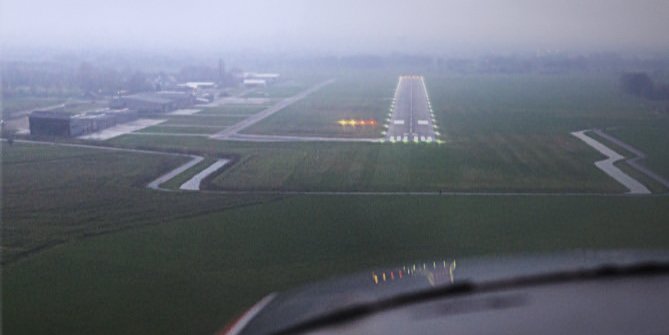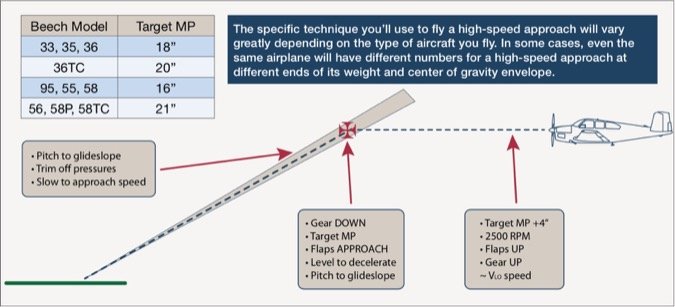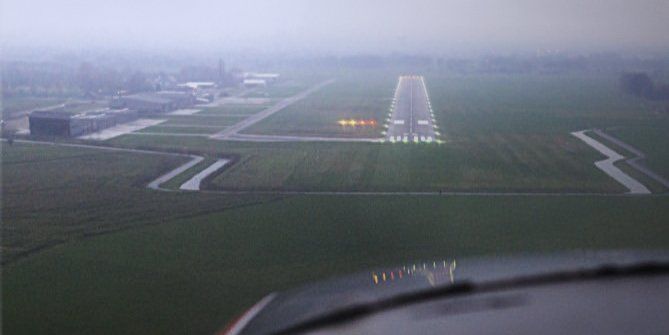
“November 12345 is cleared for the visual approach to Runway One Left, traffic is a Boeing 737 on a seven-mile final behind you, maintain best speed, contact the tower….”
Fly into a Class C or Class B primary airport and you’ll eventually be asked to “keep your speed up” because of inbound traffic behind you. Do it IFR, even at some Class D facilities, and you’d best be very ready to mix with the heavy iron, which easily could be approaching 100 knots faster than your flivver can manage.
The vastly different speeds and capabilities of airplanes from light trainers to heavy jets appear at random times from random directions, all wanting to funnel into one airport, and ATC will do its best to work as many airplanes into the airport as quickly as possible. Or you may simply want to expedite your arrival. When you need (or want) to keep your speed up on an approach, how can you do this predictably (not having to make it up as you go) while maintaining as low a workload as possible?

By The Numbers
Many pilots of high-performance aircraft learn to fly them “by the numbers.” This concept—using known settings for power, attitude and configuring secondary controls like flaps to obtain predictable airplane performance in various phases of flight—has been the standard in heavier airplanes since World War II. It’s also trickled down and has been popularized in general aviation circles by numerous instructors and authors translating airline and corporate techniques to the light airplane cockpit.
A common by-the-numbers technique is to fly approaches at the airplane’s cruise climb speed. This allows the pilot to trim the airplane for a possible missed approach. If the runway environment is not in sight at the missed approach point, or for any other reason the pilot decides to miss the approach, the airplane will trend toward the missed approach climb when you apply climb power and clean up the airframe. The early stages of a missed approach are among the highest workload normal operations a pilot can perform—a by-the-numbers technique makes it far easier and, in fact, turns a missed approach into a very gentle maneuver.
For example, in the Beechcraft Bonanzas I most frequently fly, a good cruise climb speed is 110 KIAS. To reduce the workload of a possible missed approach, I’ll fly at 110 KIAS inbound on the approach. From experience I know it takes about 18 inches of manifold pressure (MP), 2500 rpm on the propeller (the climb setting, one less thing to have to change when beginning “the missed”) and approach flaps (10-15 degrees) to maintain 110 KIAS in level flight. Extend the Bonanza’s retractable landing gear and the airplane will pitch down slightly to maintain 110 KIAS; the added drag of the landing gear causes the airplane to descend at 500-600 fpm…just about right for a standard three-degree glideslope at a range of typical final approach ground speeds.
This philosophy well works for most aircraft, in visual as well as instrument operations. A coworker purchased a 1961 Cessna 172 and asked me to help him finish his private certificate training. On our first flight in his new acquisition, we found “the numbers” for his airplane, centered on its 90 mph climb speed. We discovered that 2100 rpm, carburetor heat ON and the first notch of his manual flaps makes his airplane very predictable when trimmed for 90 mph in level flight. To descend at about 500 fpm, all he has to do is reduce the propeller speed to about 1700 rpm. In visual operations he’ll slow from there on final approach, but later when he begins his instrument training, he’ll already know this tremendous workload-saving technique.
My point: With just a little experimentation, you can find the numbers for just about any airplane, so you know how to precisely predict its performance and know ahead of time what you must do to make it do what you want.
High-Speed Approach
A second benefit of knowing the by-the-numbers technique is the ability to use it as a starting point to develop new techniques for unusual situations. One such example is a controller’s request to “keep your speed up” when approaching a towered airport with faster traffic behind you, or to sequence you with other airplanes coming in at the same time. Many years ago, using the by-the-numbers technique, I developed a second set of power, attitude and airplane configuration targets to predict airplane performance and accurately fly a high-speed approach. Let’s look at the technique for three representative types of aircraft: a retractable gear airplane with fast-acting landing gear that extends all three gear legs simultaneously (think Bonanza); a retractable gear airplane whose gear extension geometry creates significant extra drag while the gear is in transit and/or that extends one leg at a time or out of phase with the others (so its drag creates significant yawing or pitching movement while the gear is in transit—think Cessna 210) and a fixed-gear, high-performance airplane (Cirrus SR22).
Fast, Simultaneous Gear Extension
The key in airplanes of this type is to find a power setting that, in a clean configuration (gear and flaps up), results in just under the maximum landing gear extension speed (VLO) in level flight. The Bonanzas and Barons I fly are in this category. As depicted in the graphic above, presume you’ll intercept the glideslope or glidepath with this combination: gear up, flaps up, 22″ MP/2500 rpm to maintain about 150 KIAS—four knots below gear speed. That’s also a ballpark approach speed for a midweight Boeing 737, so you’re flying a jet profile to stay ahead of the following traffic.
With an eye on the ILS or GPS glideslope—or even the PAPI or VASI in clear visual conditions—watch for it to indicate the centered, “on glidepath” position. When the glideslope shows one dot high (“Fly Up”) or the PAPI/VASI is just beginning to fade into the “on glidepath” colors, you’re at the “action point.” Start with the landing gear (which is why the speed target is just below VLO):
– Extend the gear;
– Reduce power to the “normal” approach setting target—18″ MP in the case of a Bonanza;
– Extend approach flaps.
Asymmetric Or Draggy Gear Cycle
I’ve used a similar technique flying a Cessna 210. Because the 210’s gear extension geometry creates a big, temporary increase in drag while the gear is in transit and also tends to yaw and pitch during a high-speed extension, I like to use a different technique. Fly at a similar 22″MP/2500 rpm setting (or whatever it takes to remain just below VLE), but extend the landing gear in level flight a mile or two before intercepting the glideslope/glide path. Then increase manifold pressure about four inches, if available, to maintain speed with the gear out. I do this to get the yawing and pitching motions out of the way before the added task of beginning descent. At the descent action point, pull the manifold pressure back to normal descent power setting—around 17-18″ in most 210s—and add the first notch of flaps when airspeed permits.
Fixed Gear
Flying a high-performance fixed-gear airplane, use the same basic C210-type technique, except of course you don’t have the interim step of extending the landing gear. Fly at 140-150 KIAS if your airplane can manage, or just below approach flaps extension speed if that works in your aircraft. At the action point, reduce power to the normal descent setting and extend approach flaps if able.
At The Action Point
Each of the actions—lowering the gear if you do so at the action point, reducing power and extending flaps—causes the airplane to decelerate. Since the airplane will attempt to seek the indicated airspeed for which it is trimmed, this means each of the actions cause the airplane’s nose to pitch down. Apply just enough back pressure on the controls so you hold altitude through this deceleration as you glide into the glideslope or glide path. When the glideslope needle or pointer centers, or you intercept a visual glidepath, release some of this back pressure to establish a roughly three-degree nose-down attitude to follow the glideslope.
Then trim off the pressure. You’re in a somewhat paradoxical state where you might have to be pushing the nose down slightly to stay centered on the glideslope, while at the same time trimming the nose UP because the airplane is slower than the airspeed for which it is trimmed. By the time you have descended a couple hundred feet or so down the glideslope, however, you’ll be on speed, in configuration and in trim, stabilized just as if you’d flown around at the normal approach speed all day before intercepting the glideslope.
Fast to the Threshold
Sometimes you might be asked to maintain “best speed” to the runway. Remember that it is your determination what “best” is in this context. In general, this does not mean trying to maintain 140 or 150 knots until over the threshold. In most cases, the glideslope intercept point is about five miles from the runway threshold. That’s not far enough to make a great deal of difference between the time it takes to get from intercept to the ground, if you fly at the normal approach speed as compared to trying to fly faster to a point closer to the runway. In order to touch down safely without too much float, and therefore be able to clear the runway sooner to get out of the way of that following traffic that caused you to fly fast to begin with, you eventually have to slow down to land.
From ATC’s standpoint, once you are inside the final approach fix, you “own” the approach. If the following traffic is too close, it’s the controller’s mistake and the controller’s responsibility to make the other guy go around. I am all in favor of helping the controller get more airplanes to the airport by flying a faster approach. In the interest of safety, I’ll fly as fast as I can to the glideslope or glide path intercept to accommodate the flow of traffic. But then I’ll begin slowing down to fly a stabilized approach for most of the rest of the way to the runway.
This technique works best in aircraft with high landing gear extension (if retractable) and flap speeds. In all types, you’ll need to learn from others what techniques work best, or experiment to find what works best for you.

Putting It All Together
Agreeing to keep your speed up is not something you should do unless you’ve practiced a technique for doing so beforehand. You shouldn’t be making it up as you go the first time you fly a high-speed approach for real.
Most pilots find that flying by the numbers makes it far easier to manage workload and predict aircraft performance. Knowing what is “normal” for your aircraft, you can build on the technique to derive a variation of power and configuration values, the “high-speed numbers,” for cooperating when ATC asks you to keep your speed up.
Is It Stable?
Flying a high-speed approach, especially if you think you’ll fly fast all the way down to the runway, is the antithesis of flying a stabilized approach. Accidents in the landing phase of flight are quite frequently linked to unstabilized approach descents—a good landing usually comes out of a good approach, while a bad landing (or worse) almost always comes at the end of a bad approach. How does the idea of keeping your speed up fit with the extreme desirability of flying a stabilized approach?
In transports, a stabilized approach generally begins at the final approach fix (FAF) and continues to the landing flare. In lighter airplanes, we don’t necessarily need to fly a constant airspeed all the way down the glidepath from the FAF, but we do need to be on-speed, in-configuration, on glidepath and aligned with the runway for at least the last 500 feet of an approach. Like any other arrival, if you find you are deviating from any of these criteria as you get to a point 500 feet above the touchdown zone elevation, go around or miss the approach as appropriate. Don’t turn an honest desire to help ATC with the traffic flow into a landing mishap that will cause everyone else to go around until they get your airplane off the runway. Kinda defeats the purpose.
Elements of a Stabilized Approach
– Maintain a specified descent rate.
– Maintain a specified airspeed.
– Complete all briefings and checklists.
– Configure aircraft for landing (gear, flaps, etc.).
– Be stabilized by 1000 feet for IMC operations; 500 feet for VMC approach.
– Ensure only small changes in heading/pitch are necessary to maintain the correct flight path.
Type Specificity
Clearly the specific technique you’ll use to fly a high-speed approach will vary greatly depending on the specific type of aircraft your fly. In some cases even the same airplane will have different “numbers” for a high speed approach at different ends of its weight and center of gravity envelop spectra. Agreeing to keep your speed up is not something you should do unless you’ve practiced a technique for doing so beforehand. You shouldn’t be making it up as you go the first time you fly a high-speed approach for real.

Unable
When ATC asks you to keep your speed up—as with all other requests—the word “unable” always is an option. Tell the controller you’re unable to comply if the air’s too turbulent for you to fly that fast down low (e.g., above weight-adjusted VA or turbulent air penetration speed, TAPS), if you’re not fully briefed and set up for the approach you’ll fly, or if there’s any other reason you cannot or do not wish to comply with the tower’s request. The worst thing that will happen is that you’ll be vectored away and resequenced for the airport.
Tom Turner is a CFII-MEI who frequently writes and lectures on aviation safety.




